Monthly Archives: November 2017
Storage Share, Nov. 16/17, 2017
- On: November 15, 2017
 0
0
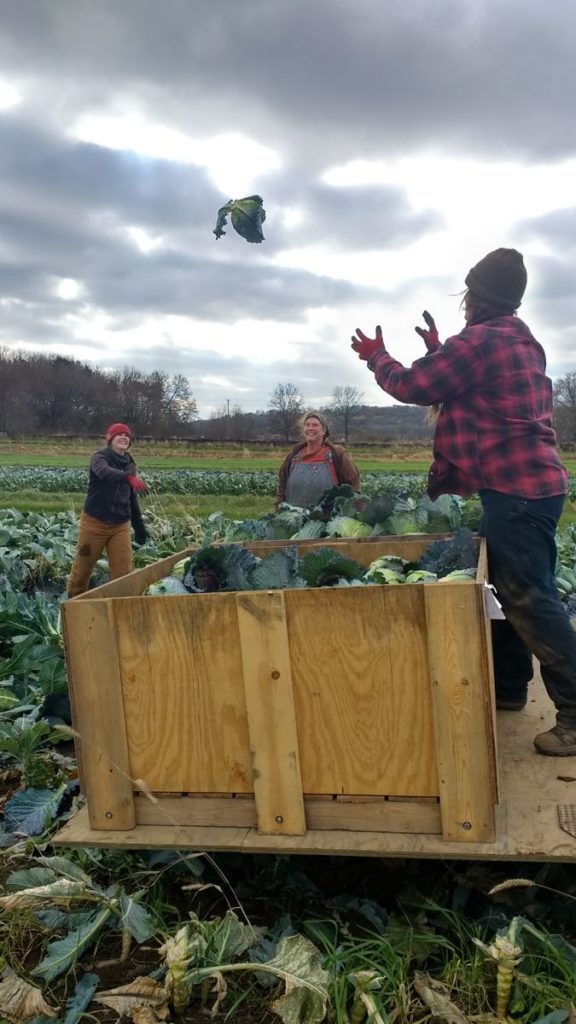
Cabbage in flight, on its way to you.
We are tantalizingly close to the end of our season. The cold spell last week hurried us along. 13 degrees! That will do some damage. With that deadline, we pulled in all but the hardiest crops. Cabbage, celeriac, even leeks can get damaged at 13o. We are still harvesting carrots. Protected in warm-enough soil, they survived the brief cold night without trouble.
Instead, trouble came as broken machinery. Our complex carrot harvester broke down unexpectedly. This is the machine we imported from Europe a few years ago. It’s a terrific harvester but largely unknown in the USA. We had to get a replacement part flown in from Germany, routed through the North American dealer in Canada. It took over a week to travel here and clear customs. Oh, this has been a tense week. As our kids say “The intensity intensifies!”
We pulled out our trusty older carrot harvester but it’s slower and requires a much bigger crew for harvest. Plus it’s more demanding physically for all of us. The replacement part arrived this morning and we got the big harvester back in the field by midmorning. If the weather holds through Friday, we will finish every field, leaving our coolers stuffed to the gills. Wish us luck.
We are ready to wrap up this season. Then we’ll enjoy the winter, with lots of cooking and ice skating and maybe even a vacation before we start plotting next year. Have a wonderful Thanksgiving! Beth & Steve
Storage Share this week
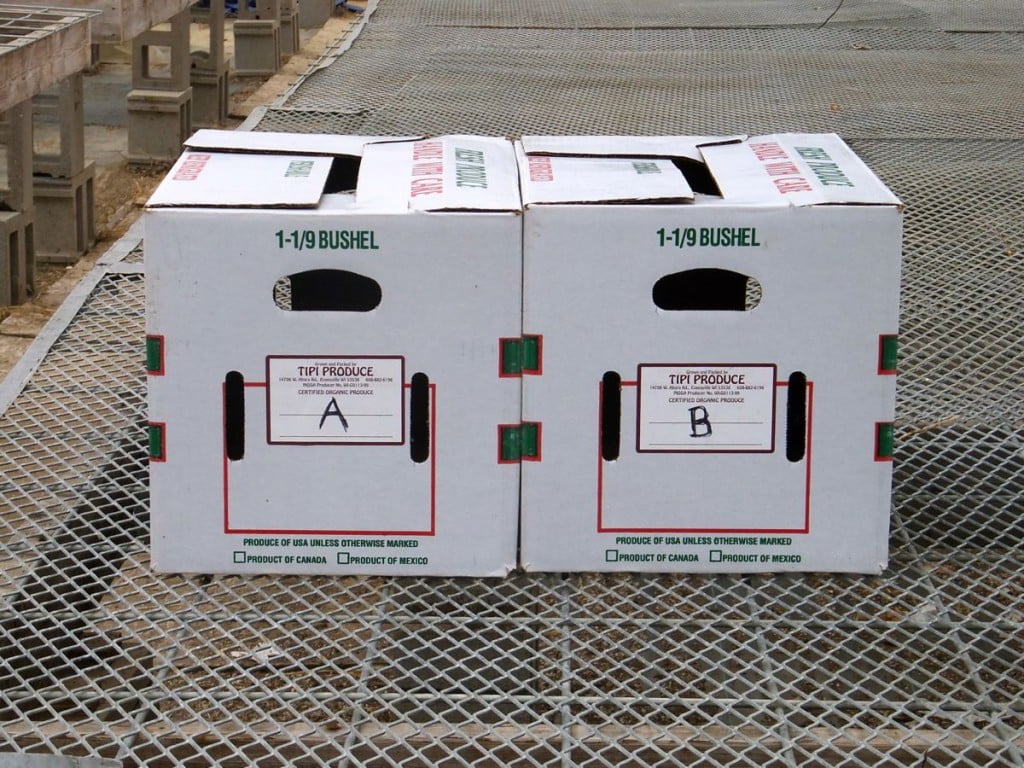
Take one box labelled “A” and one box labelled “B”.
Things you need to know about your winter share
* Your delivery will consist of two different boxes, labeled “A” and “B”. Take one “A” box and one “B” box. The boxes contain different vegetables.
* Please pick up your boxes on the day of delivery, during the normal hours for your site.
* Outpost members, please get your boxes on Friday. This is the busiest weekend of the year for the Outpost staff, so we cannot ask them to hold boxes past Friday.
* Members at outdoor sites, please carefully put the blankets back on the boxes. That keeps everyone’s produce in good shape.
* The boxes are heavy! It’s OK to take home the packed boxes, then return the empty boxes to your pickup site within two weeks. We’ll swing back and pick them up.
Veggie List and Storage Info (Storage share, Nov. 16/17, 2017)
We hope you enjoy this shipment of veggies. Strategize to use them well, as some will last longer than others.
* These are the most perishable vegetables: green cauliflower, fennel, Romanesco.
* These are the next-most perishable: Brussels sprouts, cabbage, leeks and onions. Keep an eye on your butternut, potatoes and sweet potatoes. The last two are susceptible to drying out. Expect the largest butternuts to last the longest.
* These will last the longest: Beauty Heart radish, beets, carrots, celeriac, garlic, parsnips, shallots.
Box “A”
Refrigerate everything in this box.
Beauty Heart winter radishes, 1 or 2
Brussels sprouts, on stalk(s)
Carrots, 6 lb total
….. orange ~4.5 lb
….. yellow ~1.5 lb
Celeriac, 1
Fennel, 1 fat bulb
Green cabbage
Green cauliflower, 1 very small
Leeks, ~3 lb
Parsnips, 3 lb
Romanesco cauliflower, ~2
Box “B”
The beets need refrigeration. Everything else in this box can be stored cool or at room temperature. See notes below for more detail.
Beets, 3 lb
Butternut squash, ~4
Potatoes, russet, 5 lb
Potatoes, Satina, 5 lb
Sweet potatoes, ~10 lb
Onions, 5 lb total
….. ~1 lb red
….. ~4 lb yellow
Shallots, 3
Garlic, 3
Beauty Heart radishes (round, white with pale green shoulders and bright pink interior) – Refrigerate. The interior color is lovely. Slice thinly and add to salads, cook lightly in mixed vegetable medleys or cut into matchsticks and add to pasta salads. We enjoy grated carrot and Beauty Heart salads all winter.
Beets – Refrigerate in a bag or container. Beets will store for two months or longer.
Brussels sprouts – Pluck from stalks and refrigerate in a bag or container. Do this the day you pick up your CSA boxes. Eat within 2 to 3 weeks.
Butternut winter squash – You will receive up to four butternuts, depending on size. Store your butternut in a cool, dry place. 50 F is ideal. Do not put in a plastic bag. Expect the largest butternuts to store the longest. Inspect your squash frequently and cook promptly if you see any soft spots developing. You can cook, mash and freeze the squash for future use. I find that you can refrigerate cut raw squash for up to one week. This runs counter to the accepted way to store squash, but is useful if you want to cook just half a squash. Try microwaving your squash for one to two minutes before cutting or peeling. This softens the squash and makes a large butternut easier to handle.
Cabbage – Refrigerate. Cut off chunks as needed.
Cauliflower, green – Refrigerate in a bag or container.
Carrots, orange. Refrigerate in a plastic bag. Will keep for several weeks.
Carrots, yellow. This variety is pretty AND they taste good.
Celeriac – Will store for months in your fridge. Cut off chunks as needed. Peel before using. I find it easiest to cut the celeriac into flat slices, then peel.
Garlic. Can be stored at room temperature.
Leeks. Refrigerate and eat within three weeks. Leeks are not a long-storage crop. You may need to strip off one or two outer leaves to freshen the leeks before you cook them. Your leeks will probably need washing. We finished preparing them after dark and didn’t realize how much soil was still on them.
Onions: Refrigerate or store in a cool, dark spot and protect from light. Exposure to light stimulates sprouting.
Parsnips (These look like large white carrots.) – Refrigerate in a plastic bag. Parsnips will store for two months but will darken in color. That is a harmless change.
Potatoes, Russets and Satinas – Can be stored at room temperature or in a cool spot, but must be kept in the dark so they do not turn green. A cloth or loose plastic bag draped over the paper bag will help avoid moisture loss, but do not close the plastic bag. Both types will store longer if kept cool. Around 40 – 50 F is ideal. The potatoes were grown by the Igl family near Antigo.
Russets– We got the big ‘baking’ grade so you have nice bakers for Thanksgiving. Excellent for mashed potatoes.
Satinas– These are good all-purpose potatoes, everything from roasted to potato salad. I really like this variety of yellow potato because they oven-roast so well and because they are less sweet than other yellow varieties like Yukon Golds.
Shallots – These look like small red onions, often with internal divisions into several bulbs. They can be round or oblong. Store at room temperature. This is the first time we’ve grown shallots! They seemed like a fun thing to try and have turned out nicely. Honestly, I am a novice with shallots but from what I’ve read (and eaten at restaurants) they are good in salad dressing, and caramelized and used to top dishes or sandwiches. We split some in half and roasted them with other veggies in a hot oven. They turned out mild and sweet, very nice.
Sweet potatoes – These are a mix of the Covington and Beauregard varieties. Both types have developed excellent flavor and sweetness. Some tubers have dark skins, the result of soil staining during wet weather. It’s unsightly but superficial and harmless. Store at room temperature, no lower than 55 F. Keep them on your kitchen counter where it’s easy to keep an eye on them. I like to keep ours in a paper bag so they don’t dehydrate. Cook promptly if they start to soften. The roots come in a wide ranges of sizes and all are good.
What are you cooking for Thanksgiving?
We are creatures of habit when it comes to Thanksgiving. Here are our plans so far: brined roast heritage turkey from our friends Jen and Bryce Riemer (Beth), Brussels sprouts with garlic-mustard vinaigrette (Steve), roasted sweet potatoes with garlicky yogurt dip (Sophie), glazed butternut squash (Beth), crunchy carrot-Beauty Heart salad with sesame-seed dressing (Steve), pickled onions (Beth & Ari), pickles (Beth & Ari), homemade applesauce (Ari), and apple pie (Sophie). I’ll probably make stuffing with lots of celeriac and onions but that might be overkill. We love celebrating Thanksgiving and the end of harvest season!
Menu Ideas
There are many terrific Thanksgiving menus and recipes online right now. Search any of the sites below if you are stumped about what to do with your storage share. Check out the online Thanksgiving collections soon; they get taken down quickly after the holiday.
♦ I like the lively Food52.com site. It’s a curated community site so judge a recipe’s rating and read the comments. Start at their Thanksgiving page and settle in. I want to read and cook everything on this site! Here’s a tiny subset of their current articles and recipes.
….. Thanksgiving Menu Maker
….. Freezer-Friendly Thanksgiving Dishes For the Ultra-Prepared
….. Make room for Spicy Raspberry Relish
….. The Genius Fix for Broken Gravy
….. 22 Pack-and-Go Thanksgiving Recipes
….. etc, etc.
♦ Smitten Kitchen is our go-to site for dessert recipes but has excellent veggie recipes too. Plus blogger Deb Perelman is funny. She has not posted a Thanksgiving menu yet but her recipes from last year are still accessible.
….. Thanksgiving recipe list
….. Last year, she was all about Team Casserole.
♦ 101cookbooks. Always has good vegetarian and whole-grain recipes.
♦ The New York Times has changed access to their Cooking app. They now require a paid subscription, although there appears to be occasional free access. This year, they’ve posted how to cook an entire Thanksgiving feast in a 400 degree oven, a very thorough Thanksgiving Menu Planner and many holiday-themed recipe collections, such as “Our 21 Most Popular Thanksgiving Pies“, “What to Bring to a Thanksgiving Potluck“, “Thanksgiving Casseroles” and more. If you can access it, start at their Thanksgiving 2017 page. In my opinion, Melissa Clark is the best NYT food writer. She’s practical and her dishes are always flavorful. David Tanis is my second-favorite. Recipes from Mark Bittman and Martha Rose Shulman are always worth a look.
♦ Finally, remember that we can use Local Thyme recipes all winter. Check them out for Thanksgiving ideas. Send me an email is you need the registration information.
Do you have favorite menu sites for fall and winter recipes?
If so, please share in a comment!
RECIPES FROM LAUREN
SHEET PAN CHICKEN WITH ROAST VEGETABLES
Recipe adapted from Food 52
I love the ease of this recipe. It uses one baking sheet and and a couple large bowls and comes together effortlessly while you do the dishes or tidy up. Honestly, the hardest part will be slicing the cabbage and fennel! If you feel like getting a second sheet pan dirty, throw some extra roast veggies on there and stock up on roasted veggies for the whole week! Carrots, sweet potatoes, parsnips, celeriac, potatoes and/or butternut squash would all go well with this tasty meal. Lauren.
Serves 6-8
Takes 1 hour
1 tablespoon toasted sesame oil
1/4 cup olive oil + more for drizzling
3 tablespoons soy sauce
1 tablespoon rice vinegar
1 tablespoon sriracha, optional
Kosher salt
Freshly ground black pepper
8 pieces chicken, bone-in, skin-on chicken thighs or drumsticks (or a mix)
1/2 head cabbage
1 head garlic, separated and peeled
1 large fennel bulb, cored and cut into 1-inch wedges
3 leeks, white and pale green parts only, cut int 1-inch thick slices
- Preheat the oven to 425 degrees.
- In a large bowl combine oils, soy sauce, vinegar and sriracha. Place chicken in a second large bowl. Sprinkle generously with salt and pepper. Pour 1/4 cup of the oil mixture over the chicken and let is marinade while the oven preheats.
- Cut the cabbage in half through it’s core. Set half aside for later use. Cut half you are using through to core again and keep slicing until you wind up with many wedges (all no thicker than 1-inch). Add cabbage to first large bowl (with remaining sauce not chicken) along with peeled garlic cloves, fennel, and leeks. Season with a bit of salt and pepper.
- Drizzle baking sheet with olive oil and add chicken. Spread it out evenly so not crowded and roast for 10 minutes. Remove pan from oven and nestle chicken with vegetables– tucking it under if necessary. It will feel like a lot. That’s fine! Roast for 25 minutes longer. Remove pan from oven and transfer chicken to a platter to rest. Also remove garlic if it seems to be beginning to brown at all (will depend on the size of your cloves). Continue roasting veggies for 10-15 minutes until juices have reduced and edges of veggies have caramelized ever so slightly.
- Serve veggies and chicken together with any residual sauce. Season with salt and pepper as desired.
.
JAPANESE VEGETABLE PANCAKES (OKONOMIYAKI)
Adapted from Smitten Kitchen
There is a chance that some people won’t get as excited about vegetable pancakes as me, but I swear I could eat them every single dang day. They are the perfect combination of crunchy, hearty, healthy, fresh and fried. They can be a side of a meal or a whole meal and despite all the chopping that goes into them, come together rather quickly. If you have a mandolin, this is a great time to use it.
And again, the recipe is pretty flexible. Feel free to swap in any other root veggies (in similar quantities) for the sweet potato, carrots and parsnip. Lauren.
Takes 45 minutes
Serves 4-6 (more if it’s a side dish)
1 pound Brussels sprouts, ends trimmed and very thinly sliced (you will want about 4 cups sliced sprouts)
1 medium sweet potato, peeled and julienned (about 4 cups)
2-3 carrots, peeled and julienned (about 3 cups)
1 parsnip, peeled and julienned (about 1 cup)
1 shallot, peeled and very thinly sliced
1 teaspoon Kosher salt
2/3 cup flour
4 large eggs
Vegetable oil
- In a large bowl combine Brussels sprouts, sweet potato, carrots, parsnip and shallots. Sprinkle with salt followed by flour and stir until flour coats vegetables. Stir in the eggs until mostly smooth.
- Heat a heavy large skillet over medium high heat. Coat the bottom with oil and warm until hot but not smoking. Drop 1/4 cup spoonfuls into the pan (about 4-5) so they do not crowd. Gently press the pancake down until almost flat. Cook until the edges begin to brown, about 3 minutes and then flip. Cook for 1-2 minutes until other side browns. Remove to paper towel to drain grease.
- Add more oil in between batches and continue cooking until no more batter remains. Feel free to keep the first ones warm and crisp in a 250-degree oven while you cook the rest.
- Serve warm with tangy ketchup (below), spicy mayo or other favorite Asian dipping sauce.
.
Tangy Ketchup
1/2 cup ketchup
2 tablespoons rice wine vinegar
2 tablespoons honey or maple syrup
1 tablespoon Worcestershire sauce
2 teaspoons soy sauce
1 teaspoon Dijon mustard
1/4 teaspoon ground ginger
Combine all sauce ingredients in a small saucepan and simmer until smooth and thick, about 3-5 minutes.
Extension share; Nov 2, 2017
- On: November 01, 2017
 0
0
Carrot Team
We are hurrying our storage crops from the fields to the coolers. This week, we brought in the final parsnips and daikon, plus carrots and cabbage. We hope to finish the carrot and cabbage harvests next week but the work could continue into the following week.
It takes a team to bring in the carrot harvests.

Steve drives the root harvester. We imported this implement from Sweden two years ago. Steve appreciates what this machine can do, and continues to tinker and improve it.
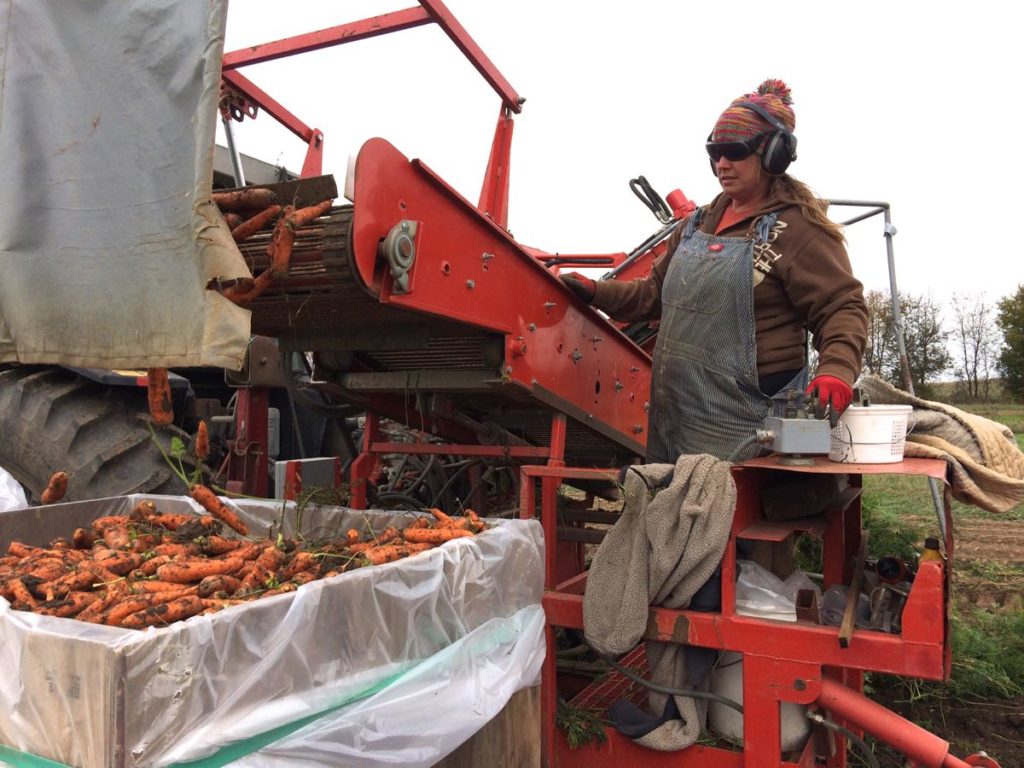
Maggie controls the harvester from the back platform. With the controls at her left hand, she distributes the carrots into a bin. Once the bin is full, she’ll send it down a ramp to the ground.
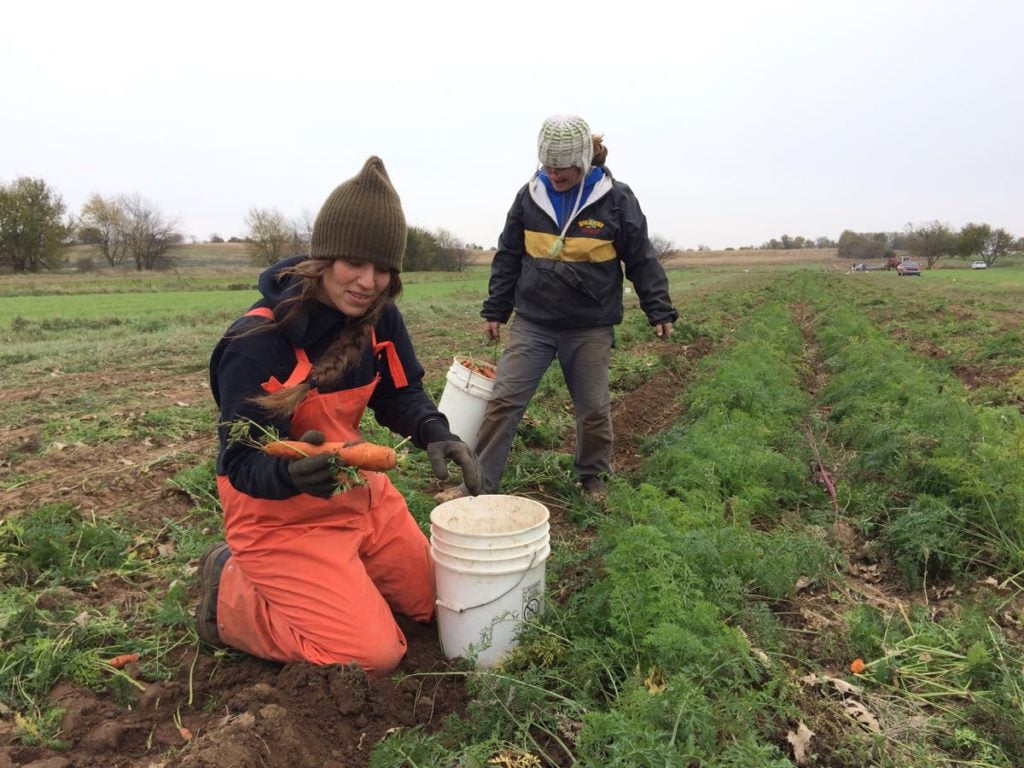
Charlotte and Kristen pick up carrots dropped by the harvester. They are too valuable to leave behind.
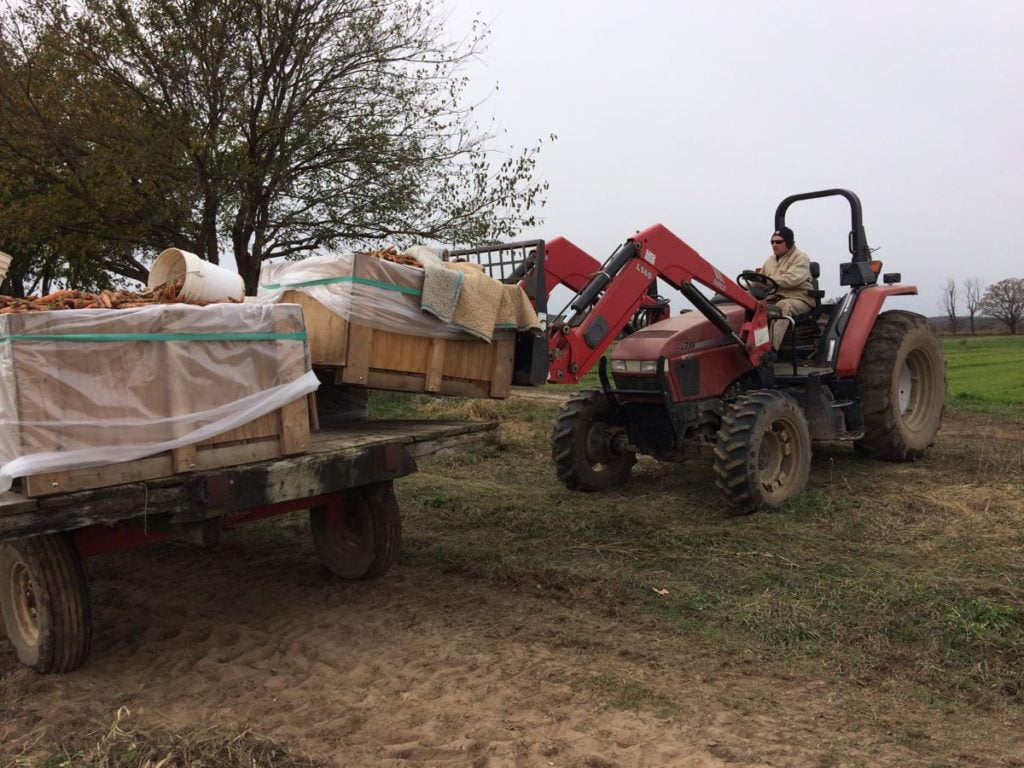
Matt picks up filled bins with the front end loader and places them on a wagon for transport back to the farmstead.
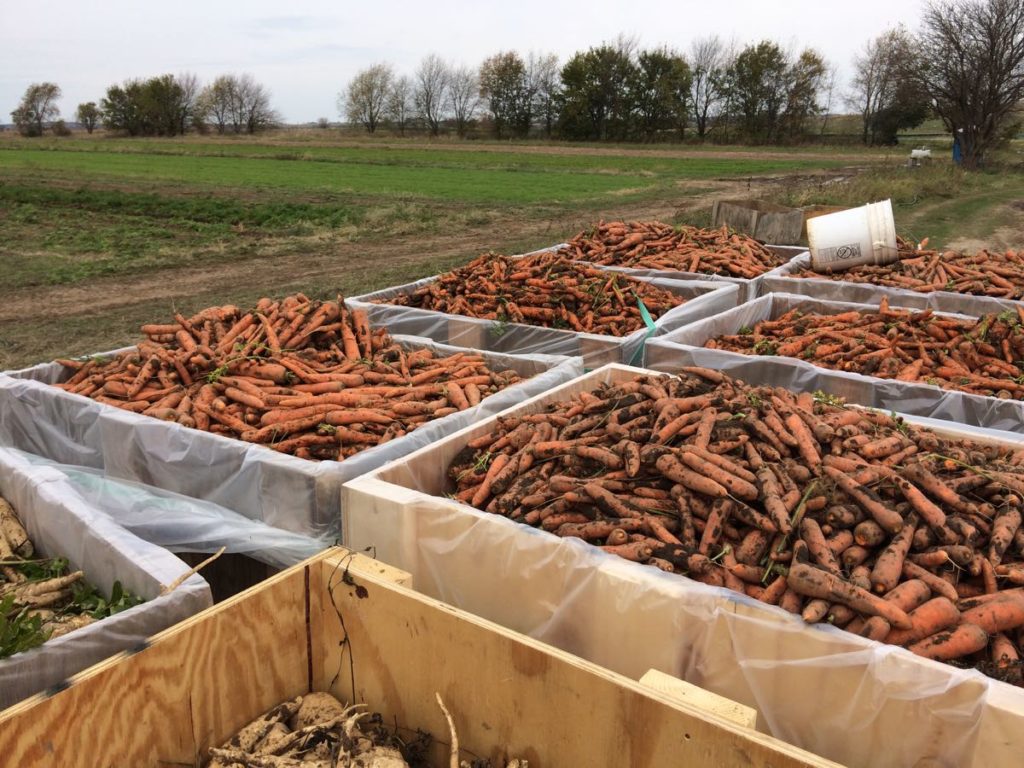
A wagon o’ carrots, plus parsnips at the front.

We cover the bins and tuck them in our cooler. We’ll wash the carrots and other roots all winter long, providing food for our customers and work for our longterm employees.
VEGGIE LIST and VEGGIE NOTES
Extension Share, 1 delivery, Nov 2/3, 2017)
Beth’s box logic:
(i) You can roast almost everything in this box. See Lauren’s recipe for roasting and sauce ideas. We routinely roast carrots, parsnips, and onions together. They cook at the same rate. Sweet potatoes get sliced, oiled, and roasted on their own sheet, because they cook more quickly. Even Brussels sprouts and Romanesco can be pan-roasted in the oven. We bought a convection oven a few years ago, and find the convection speeds roasting and evens the results.
(ii) We send the Beauty Heart radishes in combination with carrots because they make lovely, mixed salads, like Lauren’s Beauty Heart Radish, Carrot & Avocado Salad from last year.
Sweet potatoes, ~2 lb
Butternut squash
Brussels sprouts, ~1 lb
Romanesco, 1 head
Broccoli, 1 head
Carrots, 2 lb
Parsnips, 1.5 lb
Beauty Heart radish, 1 or 2
Yellow onion
Leek, 1 large
Jalapeno chile
Beauty Heart radishes (round, white with pale green shoulders and bright pink interior) – Refrigerate. The interior color is lovely. Slice thinly and add to salads, cook lightly in mixed vegetable medleys or cut into matchsticks and add to pasta salads.
RECIPE LOG
Visit our Recipe Log, a list of all our 2017 recipes. Look for Brussels sprout recipes in the past two weeks (Oct 19, Oct 26)
LOCAL THYME RECIPES
Comforting Classics
Squash Chickpea Curry with Parsnips and Romanesco
Vegan Miso Soup with Winter Squash
Mashed Carrots, Parsnips and Sweet Potatoes
Sweet Potato Posole with Black Beans
Outside the Box Recipes
Steamed Romanesco with Mustard Butter
Roasted Vegetables with Goat Cheese Crostini and Pumpkinseed Oil
Black Pepper Tagliatelle with Parsnips and Pancetta
Elbows with Sweet Potato, Capers and Parsley
Quick and Easy Meal
Hazelnut Butter Sandwich with Beauty Heart Radish
RECIPES FROM LAUREN
ROASTED FALL VEGGIES with TURMERIC TAHINI SAUCE
Adapted from Dishing Up The Dirt
Something about fall abundance just has me cooking in huge batches to prepare for the cold days ahead. I love roasting up tray after tray of veggie on Sundays, sticking them in my fridge and using them as a base all week long. These veggies are great on their own or you can turn them into a meal with some baked fish, grilled steak or a pile of wild rice. Lauren
Beth’s note: I love the sound of this tahini sauce. We roast vegetables every week through the winter. As Lauren points out, they make versatile leftovers. Our go-to sauces are sriracho mixed with mayo, or yogurt seasoned with salt, garlic, smoked paprika, and good olive oil.
Takes 1 hour
Serves 8
4 cups peeled and chopped sweet potato
2 cups peeled and chopped parsnips
2 cups chopped carrots
1 pound Brussels sprouts, ends trimmed and halved
1 head broccoli or romanesco, cut into bite-size florets
6 tablespoons olive oil
2 teaspoons Kosher salt
1 teaspoon dried thyme
1/2 teaspoon freshly ground black pepper
1/4 teaspoon cayenne powder
1 watermelon radish, thinly sliced
Turmeric Tahini Sauce
1 cup tahini
1/4 cup rice wine vinegar
1/4 cup soy sauce (or tamari)
2 tablespoons peeled and freshly grated ginger
2 teaspoons dried turmeric (unless you can get your hands on some fresh stuff– then use 2 tablespoons freshly grated)
1 tablespoon maple syrup
3/4 cup water, plus more if needed
- Preheat oven to 400 degrees.
- In a huge bowl, combine sweet potatoes, parsnips, carrots, brussels sprouts, and broccoli or romanesco with oil, salt, thyme, pepper and cayenne. Stir until everything is evenly coated with oil and spices. Pour out onto three baking sheets or roasting pans. (If you don’t have a huge bowl, just combine all ingredients on baking sheets as evenly as you can.)
- Roast for 40-45 minutes or until veggies are tender and beginning to brown in places. Halfway through roasting, make sure to turn veggies and rotate pans for more even cooking.
- While the veggies roast, prepare your sauce by combining all ingredients in a food processor and pulsing to combine. If you don’t have a food processor, you can absolutely just whisk all ingredients together in a medium bowl (it’s just easier to break up the tahini with a food processor). If the mixture looks too thick, add more water. If it’s too thin, add a bit more tahini. Taste and adjust seasonings as desired. More syrup for sweetness. More vinegar to brighten it up. More soy sauce if you think it needs more salt.
- Serve veggies warm with a generous amount of sauce drizzled over them. Garnish with radish slices.
.
CURRIED BUTTERNUT SQUASH SOUP
Adapted from Minimalist Baker
This soup just feels like fall. I love it on a cold night buried in blankets on the couch. Soup is always warming, but the creamy coconut milk and soothing curry and cinnamon spices really boost the coziness factor. Add the garnishes if you’re feeling fancy but don’t worry if you’d rather skip them. The soup very much stands up well on its own. Lauren
Serves 4-6
Takes 40 minutes
2 tablespoons butter (or coconut oil if vegan)
1 yellow onion, peeled and diced
1 leek, white and pale green parts only, peeled and diced
1 jalapeno, seeded and diced
6 cups butternut squash, peeled and diced
2 tablespoons favorite curry powder
1/2 teaspoon Kosher salt
1/4 teaspoon freshly ground black pepper
1/4 teaspoon ground cinnamon
2 cups water.
2 cups chicken or vegetable broth
1 can coconut milk (I always use full-fat but you can also use low-fat)
2 tablespoons maple syrup
Greek yogurt, optional
Sriracha, optional
Toasted pepitas, optional
- In a large stock pot, melt butter over medium heat. Add onion, leek and jalapeno. Saute for about 10 minutes until veggies are very tender and fragrant.
- Add squash and spices. Stir to combine well. Cover and cook for 5 minutes, stirring occasionally. If spices begin to stick to the bottom of the pot, just add a cup of water early.
- Add remaining water, broth, coconut milk and maple syrup. Bring mixture to a boil, reduce to a simmer and cook for 15 minutes until squash is tender.
- Let soup cool for a few minutes then puree with an immersion blender. Taste and adjust seasonings as desired. If it’s too thick, add a bit of water.
- Serve warm with optional garnishes of yogurt, sriracha and pepitas.
.



